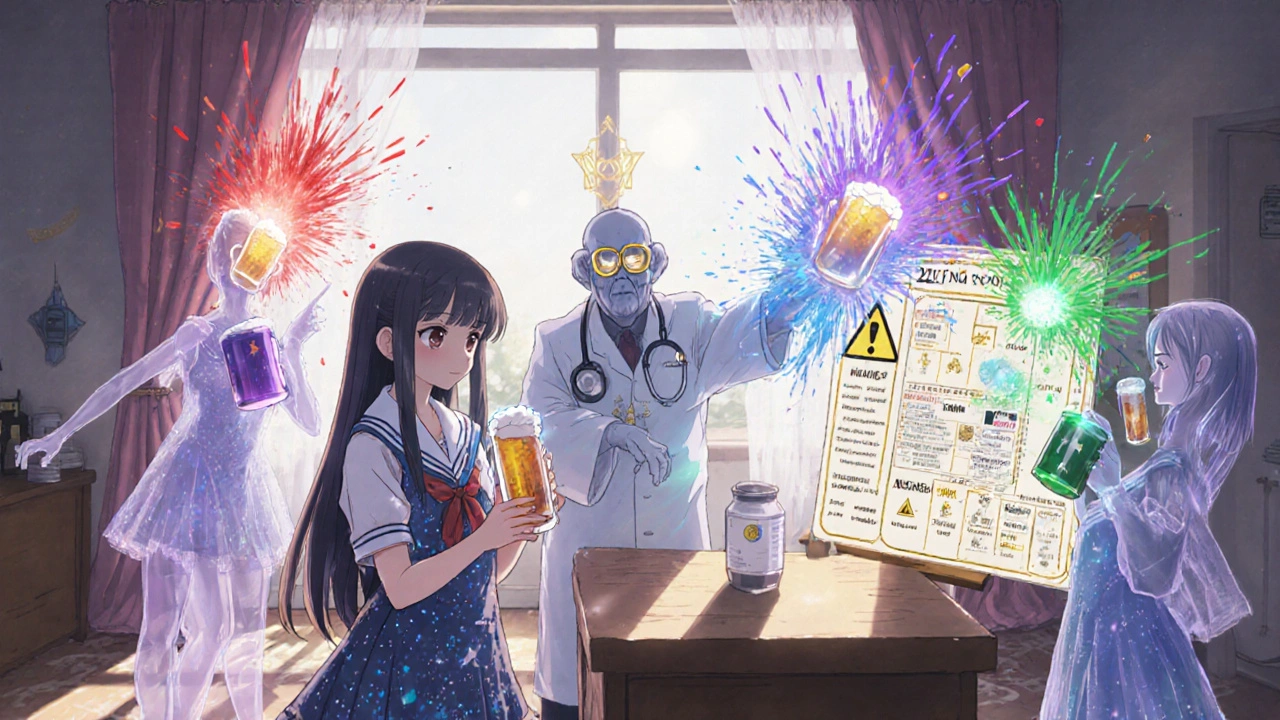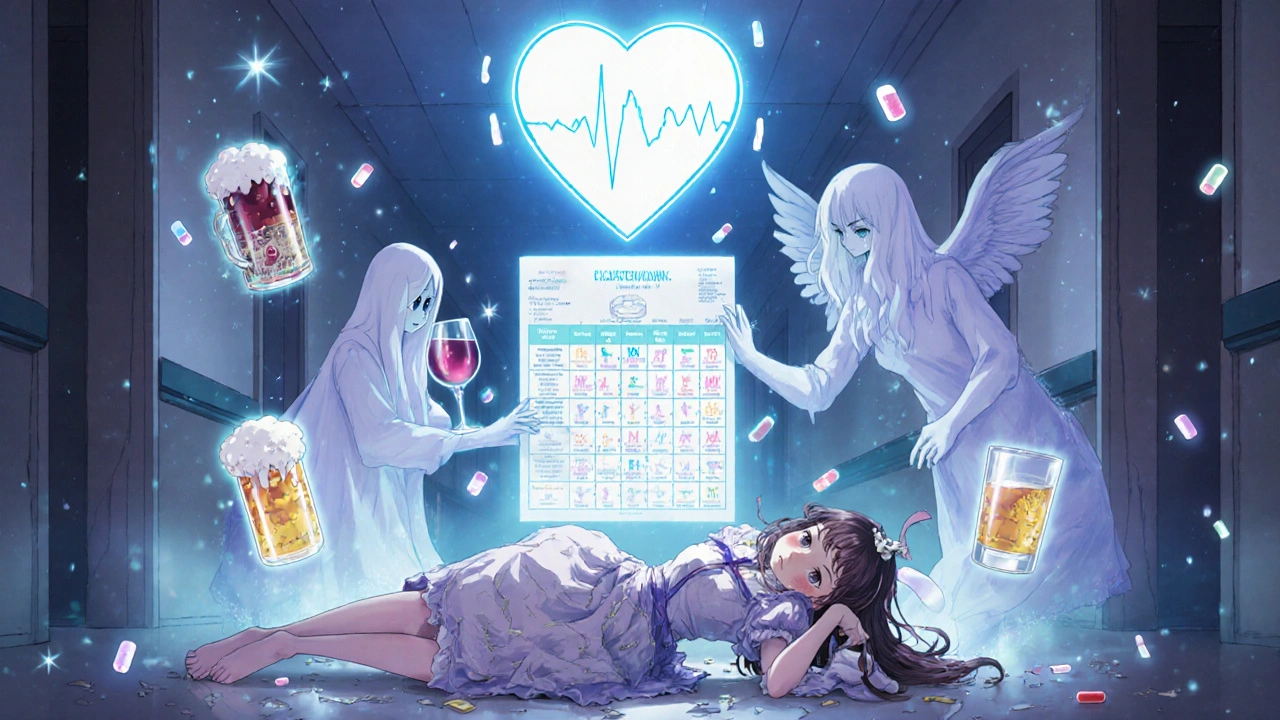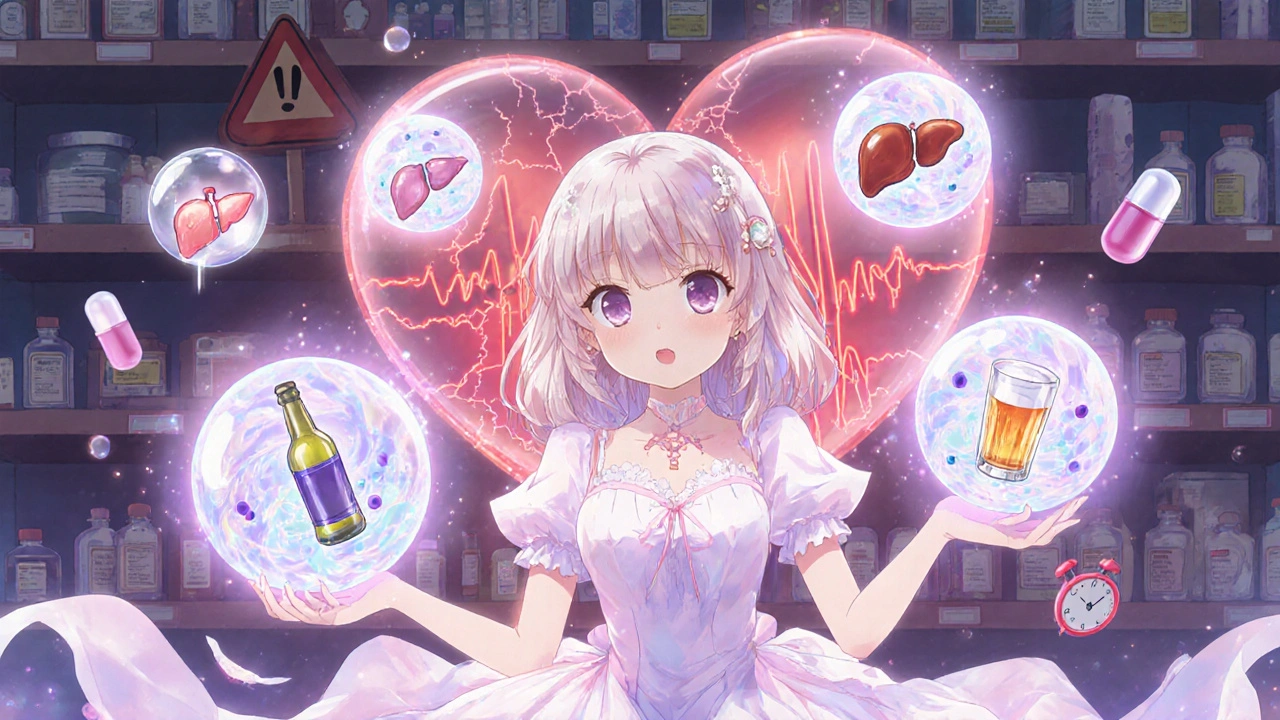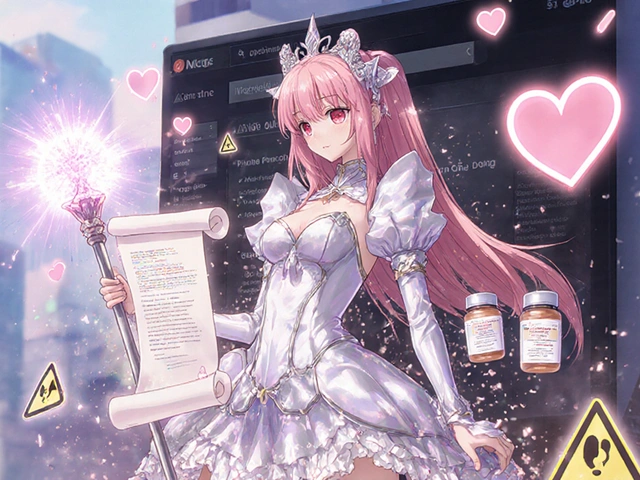Alcohol Standard Drink Calculator
Standard Drink Calculator
The article explains that 1 standard drink contains 14g of pure alcohol, whether it's beer, wine, or spirits. This tool helps you calculate how many standard drinks you're consuming.
Your Drink Breakdown
1 Standard Drink
12 oz beer / 5 oz wine / 1.5 oz spirits
2 Standard Drinks
24 oz beer / 10 oz wine / 3 oz spirits
3 Standard Drinks
36 oz beer / 15 oz wine / 4.5 oz spirits
Risk Level
The article states: "Never mix more than one standard drink with medication." Your current calculation shows 0 standard drinks.
It’s not just about how much you drink-it’s about what you’re mixing it with. Millions of people take prescription meds and have a drink, thinking it’s harmless. But here’s the truth: alcohol and medication interactions don’t care if it’s a glass of wine, a pint of beer, or a shot of whiskey. The danger isn’t in the label-it’s in the ethanol.
One Drink, Same Risk
A 12-ounce beer, a 5-ounce glass of wine, and a 1.5-ounce shot of spirits all contain the same amount of pure alcohol: 14 grams. That’s one standard drink. And when it comes to how your body handles medication, that’s all that matters. Your liver doesn’t distinguish between beer and bourbon. It processes ethanol the same way, no matter the source. The enzymes-alcohol dehydrogenase and aldehyde dehydrogenase-that break down alcohol also fight for space with the enzymes that break down your pills. When alcohol takes up space, your meds build up. That’s when side effects get dangerous. Studies show that even one standard drink can boost the sedative effects of benzodiazepines, sleep aids, or opioids by 300% to 500%. That’s not a slight drowsiness. That’s confusion, slowed breathing, or worse. And it doesn’t matter if you sipped wine slowly or knocked back a shot. Blood alcohol concentration is the real culprit.Why Spirits Feel More Dangerous (And Why They Are)
Spirits aren’t inherently more toxic than beer or wine. But they’re more dangerous in practice. Think about it: you can drink a whole bottle of beer over an hour. But a shot of vodka? That’s gone in 10 seconds. Faster consumption means faster spikes in blood alcohol levels. Clinical trials show that rapid ethanol delivery-like what happens with spirits-leads to 40% stronger interactions with CNS depressants than the same dose sipped slowly. Emergency room data backs this up. Sixty-eight percent of alcohol-medication overdose cases involve spirits. Why? Because people think, “It’s just one shot.” They don’t realize that one shot delivers the same alcohol as a whole beer-but hits their system like a sledgehammer.Beer Isn’t Safe Just Because It’s “Light”
Beer’s low alcohol content (usually 4-7%) tricks people. “I had three beers,” they say. “It’s not that much.” But three beers = three standard drinks. That’s the same as three shots. The CDC reports that beer accounts for over half of all alcohol consumed in the U.S. And because people drink more of it, they’re more likely to accidentally overdose on alcohol while on meds. Half of all unintentional alcohol-medication interactions involve beer. And here’s another hidden risk: beer often gets mixed with NSAIDs like ibuprofen or naproxen. People take them for a headache after a game. But alcohol + NSAIDs = stomach bleeding. Studies show 63% of users who reported stomach bleeding after drinking beer with painkillers didn’t realize the combo was dangerous.Wine: The “Healthy” Myth
Red wine gets a pass because of antioxidants. People believe it’s “better” for you-and therefore safer with meds. It’s not. Yes, red wine contains polyphenols and tannins. One Mayo Clinic study found these compounds slightly increased bleeding risk when taken with warfarin (a blood thinner), compared to the same amount of alcohol from spirits. That’s because the polyphenols interfere with platelet function. But here’s the bigger issue: wine is often consumed with antibiotics. And for certain ones-like metronidazole or tinidazole-any alcohol, even a sip of wine, triggers a nasty reaction. Flushing, pounding heart, vomiting, nausea. It’s called a disulfiram-like reaction. Eighty-two percent of people who experienced this said they thought “a little wine wouldn’t hurt.” And don’t fall for the “red wine is safer” myth. A 2022 survey of over 5,000 adults found 41% believed red wine was less risky than other alcohol with meds. Those people had more severe reactions.
What About Non-Alcoholic Beer?
It’s not zero. Non-alcoholic beer still contains up to 0.5% alcohol. That’s tiny-but if you’re on medication that’s extremely sensitive, like certain antifungals, seizure drugs, or chemotherapy agents, even that little bit can matter. A 2023 KFF poll found only 18% of adults knew non-alcoholic beer could still interact with meds. Most assume “non-alcoholic” means safe. It doesn’t. If your doctor says “no alcohol,” they mean no alcohol-even the kind that claims to be alcohol-free.The Real Rule: Abstain or Be Precise
The safest advice? Don’t drink at all when you’re on high-risk meds. That includes:- Benzodiazepines (Xanax, Valium)
- Opioids (oxycodone, hydrocodone)
- Antidepressants (especially MAOIs)
- Antibiotics (metronidazole, linezolid)
- Blood thinners (warfarin)
- Painkillers (acetaminophen, NSAIDs)
What Pharmacists Are Doing About It
Pharmacists are starting to push back. In Australia and the U.S., new systems now flag alcohol-medication risks during prescription filling. Epic Systems, the biggest EHR platform, reported a 34% drop in adverse events after adding beverage-specific warnings in 2022. The FDA is now requiring drug makers to provide data on how different alcohol types affect their products. By 2025, most electronic health records will automatically warn you if your prescription interacts with spirits, wine, or beer-not just “alcohol.” And there’s good news: patients who use visual aids-like a standard drink chart-get it right 89% of the time. Without them? Only 38% understand the risk.
Real Stories, Real Consequences
Reddit threads from r/Pharmacy and r/AskDocs are full of near-misses:- A 58-year-old man took one shot of whiskey with his sleep med. Woke up confused, fell, broke his hip. Didn’t remember a thing.
- A woman drank two glasses of wine with her antidepressant. Ended up in the ER with dangerously low blood pressure.
- A teenager had a few beers with his ADHD meds. Passed out in class. His parents thought it was just “being tired.”
What You Can Do Today
1. Check every new prescription. Ask your pharmacist: “Does this interact with alcohol?” Don’t assume they’ll tell you. 2. Use a standard drink chart. Keep one on your phone. Know what one drink looks like in beer, wine, or spirits. 3. Don’t rely on how you feel. You might not feel drunk, but your meds are still being affected. 4. Don’t trust myths. Red wine isn’t safer. Beer isn’t mild. Spirits aren’t the only danger. 5. Use apps like GoodRx’s Alcohol Check. Scan your pill and type in what you drank. It tells you if it’s risky.Bottom Line
It’s not about the type of alcohol. It’s about the amount. And whether you’re willing to risk your health for it. Your liver can’t handle both your meds and your drink. One of them has to give. And if it’s your meds? That’s when things go wrong. If you’re on any prescription, ask yourself: Is one drink worth it?Can I have one glass of wine with my antidepressant?
It depends on the antidepressant. Some, like MAOIs, can cause life-threatening reactions with even small amounts of alcohol. Others, like SSRIs, may increase drowsiness or dizziness. Always check with your doctor or pharmacist. There’s no safe gray area-especially since alcohol can worsen depression over time.
Is beer safer than spirits with painkillers?
No. Both beer and spirits carry the same risk when mixed with painkillers like acetaminophen or NSAIDs. The danger comes from the total alcohol dose, not the drink type. But because people drink more beer, they’re more likely to accidentally exceed safe limits. One beer might seem harmless, but three beers = three shots of risk.
Why do some medications say “avoid alcohol” but don’t specify type?
Because the risk comes from ethanol-the chemical in all alcoholic drinks. The FDA and other regulators don’t differentiate between beer, wine, or spirits because the mechanism is the same. However, newer guidelines are starting to note that spirits pose higher risk due to faster consumption. Always assume “alcohol” means all types.
Does alcohol make antibiotics less effective?
Generally, no-alcohol doesn’t stop most antibiotics from working. But it can worsen side effects like nausea, dizziness, and liver stress. For certain antibiotics like metronidazole or tinidazole, alcohol causes severe reactions. Even if your antibiotic isn’t one of those, drinking while sick slows recovery. Your body needs to heal, not detox.
Can I drink alcohol the day after taking a medication?
It depends on the drug. Some meds stay in your system for days. For example, fluoxetine (Prozac) can linger for weeks. If you’re on a long-acting drug, alcohol can still interact even if you took your pill 24 hours ago. When in doubt, wait at least 48 hours after your last dose. And if you’re unsure, ask your pharmacist.
Are there any medications where a little alcohol is okay?
A few low-risk meds, like certain antihistamines or topical creams, may allow occasional light drinking. But even then, it’s not recommended. The safest approach is always to avoid alcohol unless your doctor or pharmacist gives you a clear green light. Don’t guess. Ask.





Connor Moizer
One shot of whiskey with my sleep med? Yeah, I did that. Woke up on the floor. Didn't remember falling. My dog was licking my face like I was a lost taco. Don't be that guy.
Liam Dunne
Real talk: I used to think beer was ‘safe’ because it’s ‘light.’ Then I mixed three with ibuprofen after a game and spent two days vomiting in the bathroom. The liver doesn’t care if it’s a pint or a shot. It just wants to die in peace.
Vera Wayne
My pharmacist showed me a chart with actual glasses-beer, wine, shot-and I finally got it. I used to think ‘one drink’ meant ‘one beer’... but now I know it’s one drink, period. Changed my life. Seriously.
Phil Best
Y’all act like this is news. In India, they have this thing called ‘desi medicine’-where you drink rum with your blood pressure pills and call it ‘Ayurvedic synergy.’ I’ve seen men pass out at weddings because they thought ‘a little spirit’ was ‘good for circulation.’
It’s not synergy. It’s a death waltz.
Sharon Campbell
non alcoholic beer?? lmao so now even the fake stuff is dangerous?? next they’ll say water interacts with my meds. i’m just gonna stop taking meds and drink 3 beers a day. at least i’ll be happy.
sara styles
They’re lying. This is all a Big Pharma scam. Alcohol doesn’t interact with meds-it’s the glyphosate in the beer that’s the real problem. The FDA doesn’t want you to know that alcohol is actually a natural enzyme booster, and they’re suppressing the data because Big Pharma profits from people being scared to drink. I’ve been on 12 meds for 15 years and I drink whiskey every night. Still alive. They’re all just fearmongering.
Also, my cousin’s neighbor’s dog got into a bottle of wine and lived. So there.
Erika Lukacs
There is an existential truth here: we are all temporary vessels for biochemical processes, and alcohol is merely a foreign agent disrupting the delicate equilibrium of enzymatic harmony. The question is not whether one drink is safe, but whether we are willing to accept our own fragility in the face of chemical inevitability.
Perhaps the real danger is not ethanol-but our refusal to acknowledge our mortality.
Parv Trivedi
As someone who takes medicine daily, I appreciate this post. I used to think wine was fine because it’s ‘healthy.’ But now I know: it’s not about the drink, it’s about the dose. I stopped drinking entirely. My sleep improved. My anxiety dropped. Sometimes the best medicine is just saying no.
Patrick Merk
Man, I remember my granddad-he’d have a glass of sherry with his heart pills every night. Said it ‘helped the medicine go down.’ He lived to 92. Maybe there’s something to tradition?
But then again, he also smoked cigars and walked 10 miles daily. So maybe it’s not the sherry… just the sheer stubbornness.
Philip Rindom
So… if I drink one beer with my antidepressant, I’m basically just a walking time bomb? Cool. So I’ll just have two. Double the risk, double the fun. 🤷♂️
Rodney Keats
My therapist said I need to ‘reduce stress.’ So I started drinking. My meds said ‘no alcohol.’ So I stopped seeing my therapist. Problem solved.
Laura-Jade Vaughan
OMG this is sooo true!! I had a glass of red wine with my Zoloft and my heart started doing the cha-cha 😵💫 I thought it was a ghost… turns out it was just ethanol + SSRIs. Now I only drink kombucha. 🌿🍷 #alcoholisnotyourfriend
Willie Randle
Let’s be clear: the FDA doesn’t distinguish between beer, wine, and spirits because ethanol is ethanol. The difference lies in consumption speed, not chemical structure. This article correctly identifies the real issue: behavioral patterns, not beverage labels. Misinformation thrives where education fails.
roy bradfield
Did you know that the WHO has been quietly funding studies to prove alcohol is safe with meds? No, wait-they’re not. But the pharmaceutical industry is. They want you to believe that one drink is dangerous so you’ll buy more pills. Think about it: if everyone stopped drinking, drug sales would plummet. That’s why they scare you with stories of ‘one shot’ causing death. It’s not the alcohol-it’s the profit motive. And they’re using your fear to sell you more antidepressants, more painkillers, more everything. Wake up.
I’ve been drinking whiskey with my blood pressure meds for 17 years. My doctor says I’m ‘high risk.’ I say I’m high on life.
Jennifer Stephenson
One drink. Same risk. Don't drink with meds.
kanishetti anusha
I read this and immediately texted my mom. She’s on warfarin and drinks a glass of wine every night. She said, ‘But it’s red wine, it’s good for the heart!’ I sent her this article. She cried. Then she called her pharmacist. Now she’s on a non-alcoholic wine substitute. She says it tastes like grape juice… but at least she’s alive. Thank you for writing this. I needed to share it.